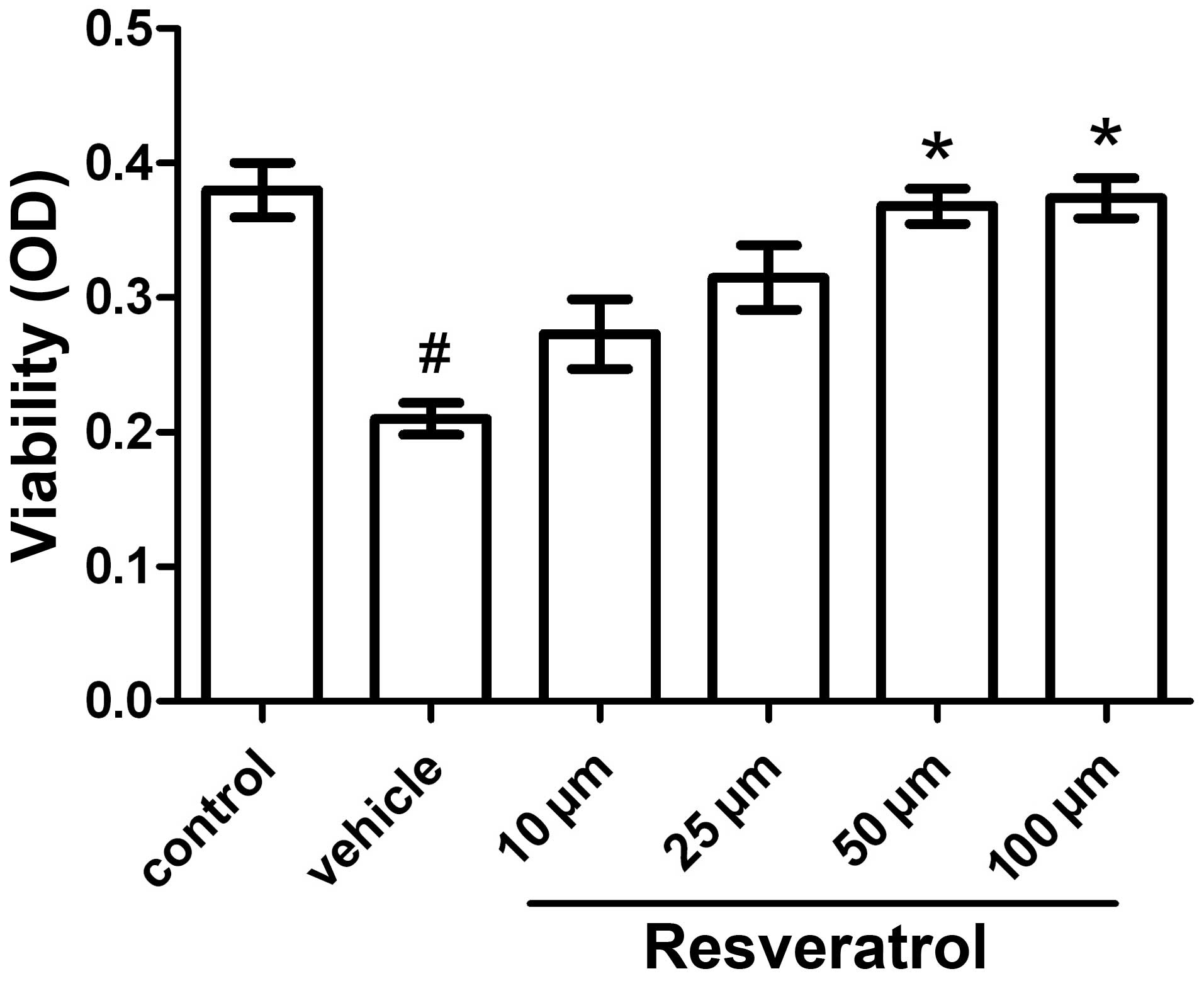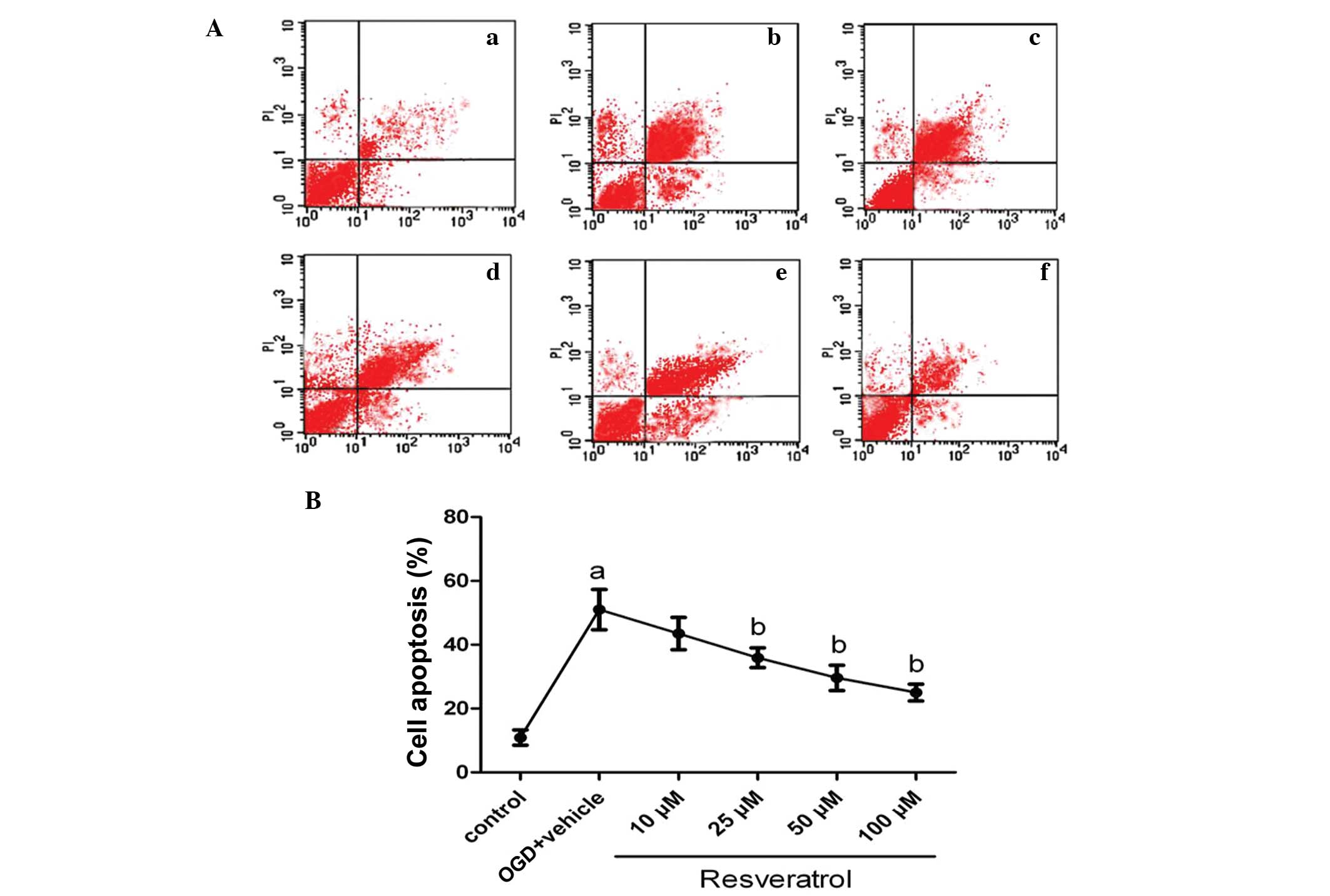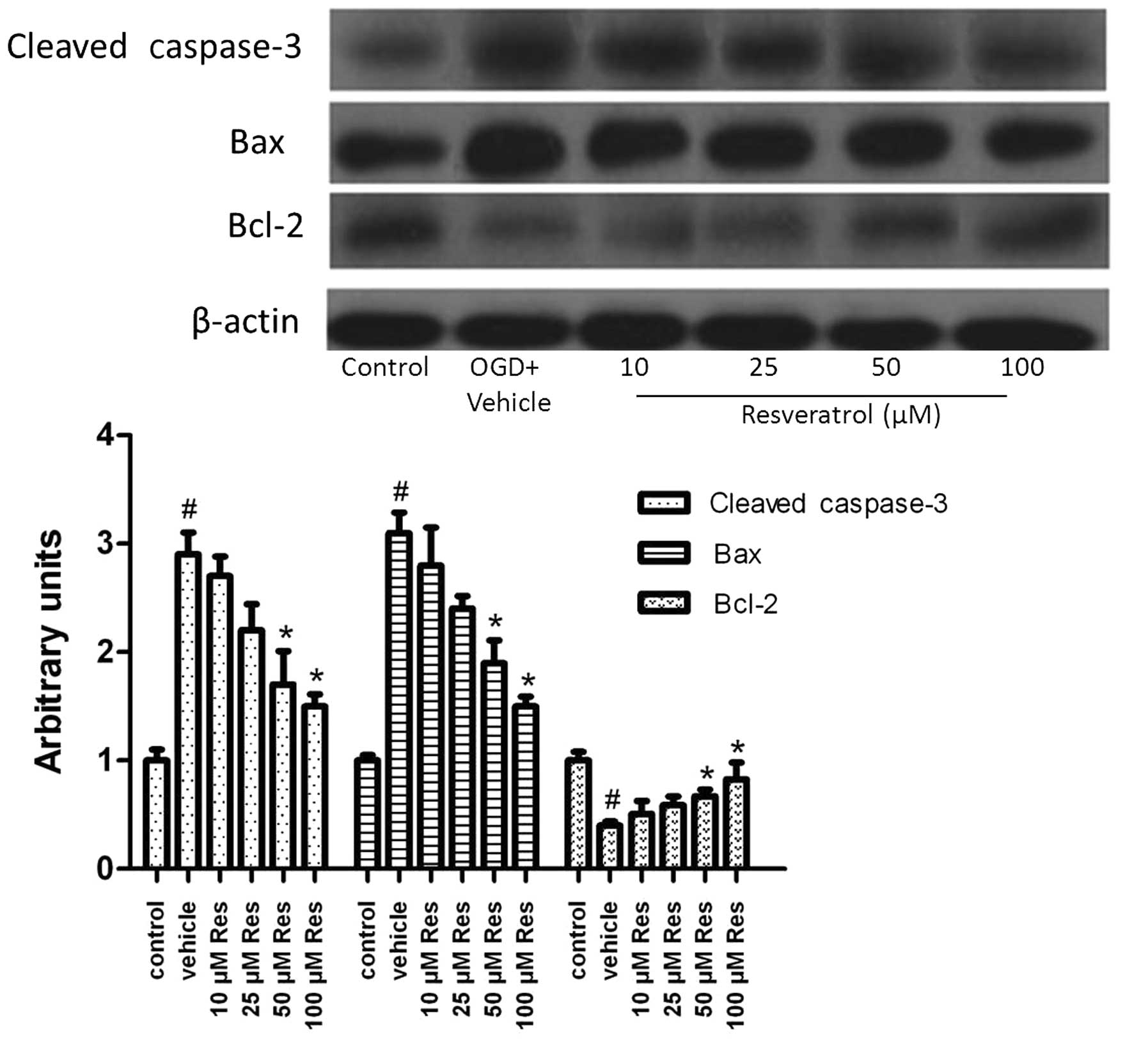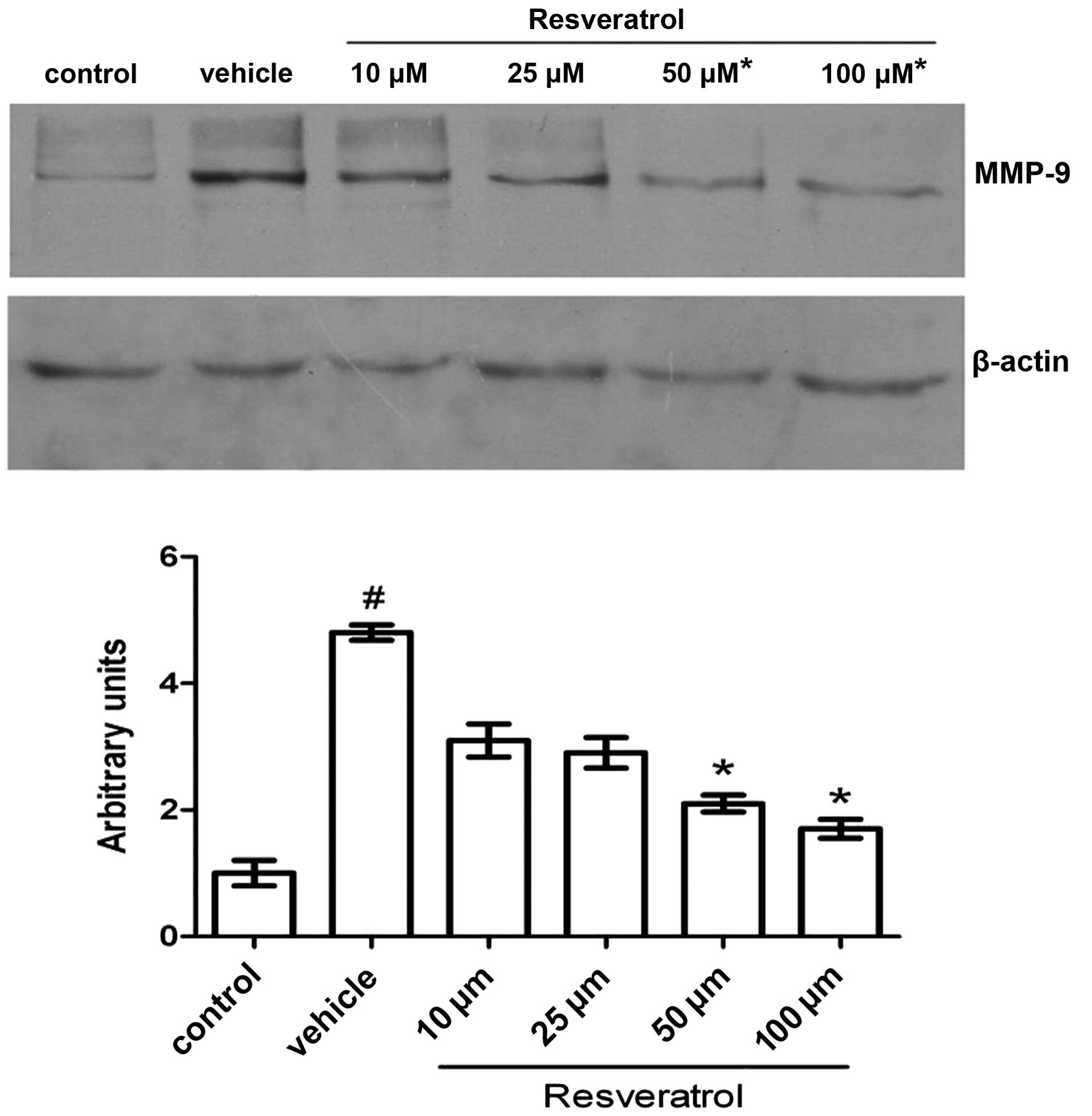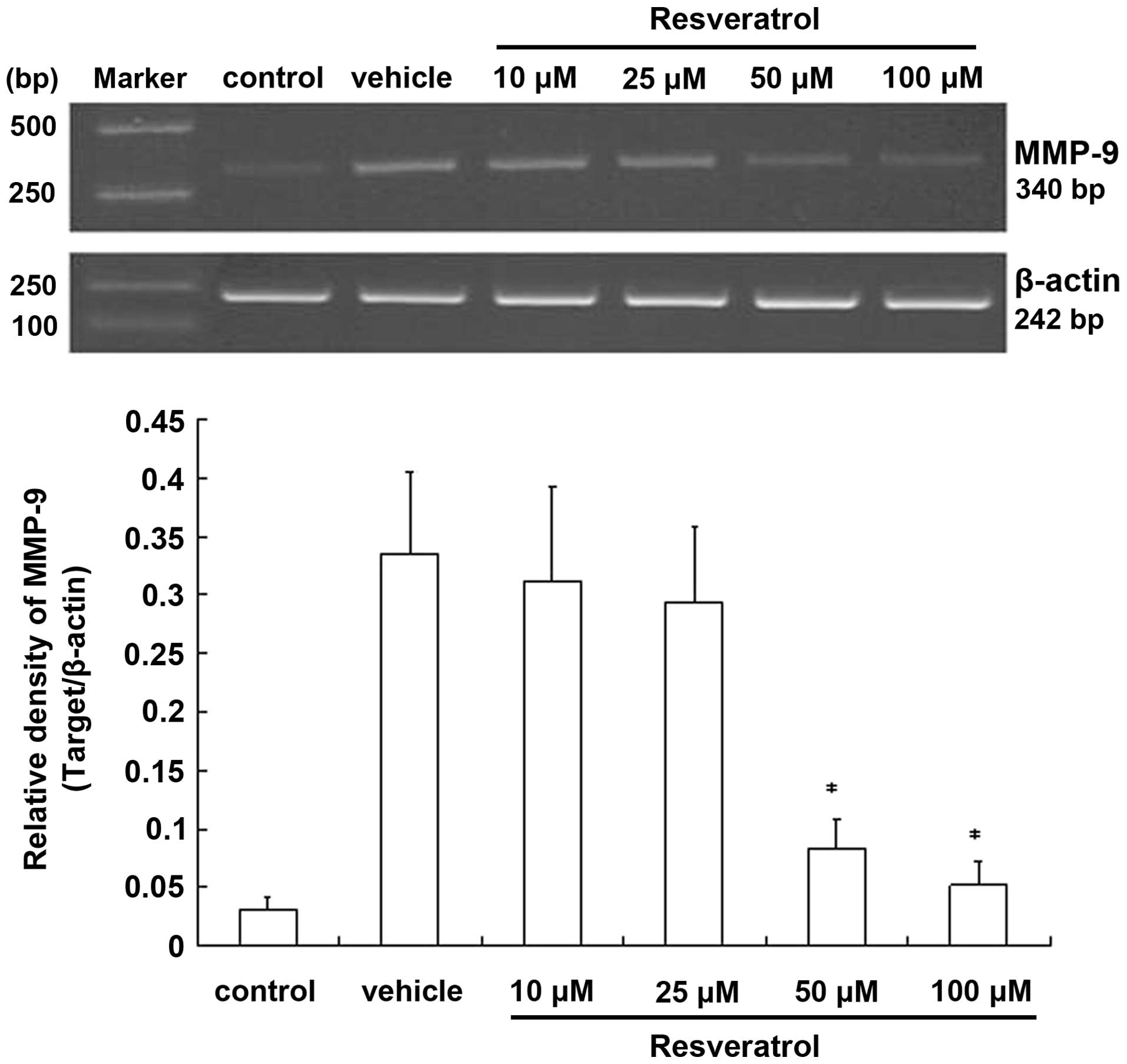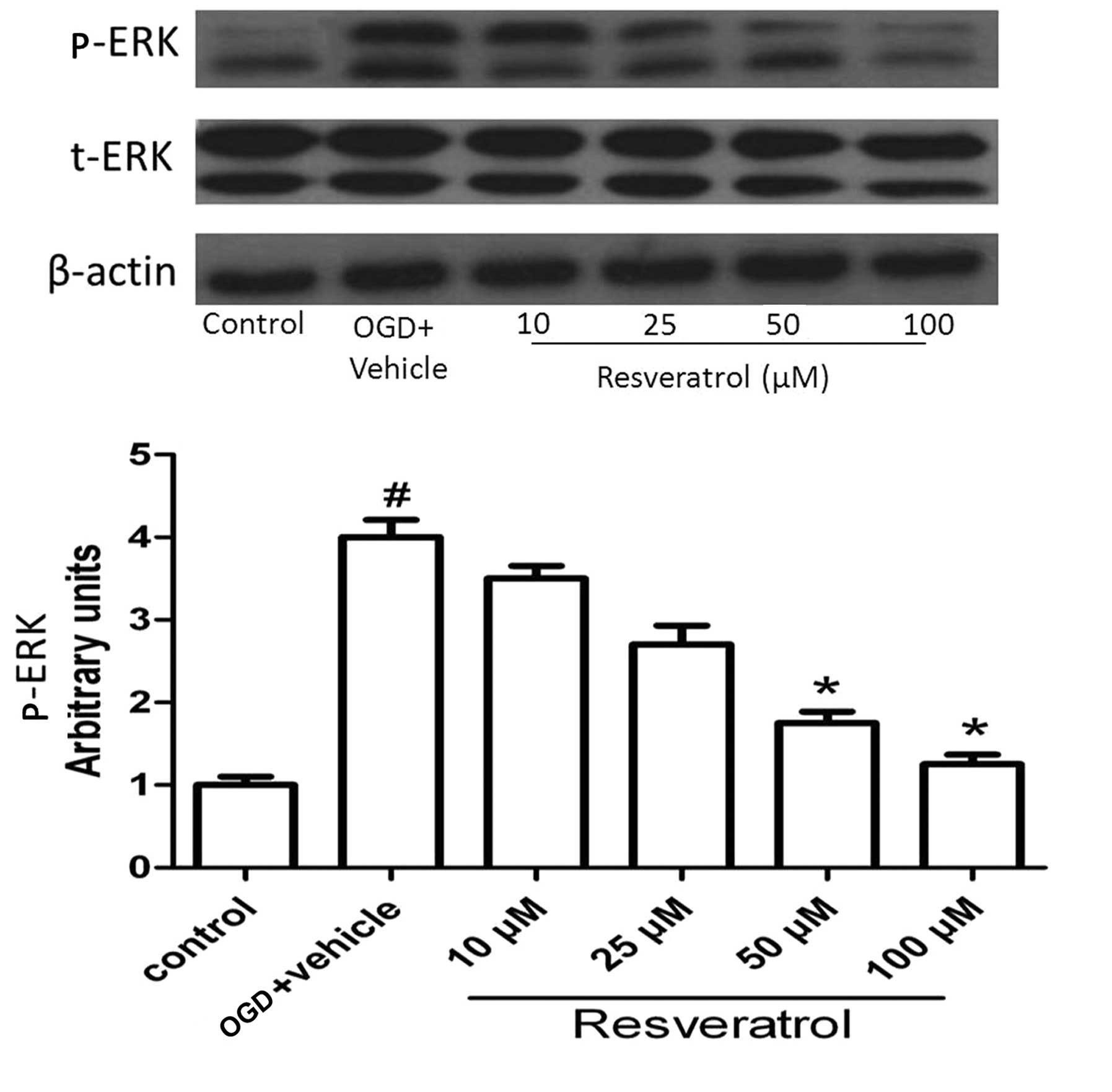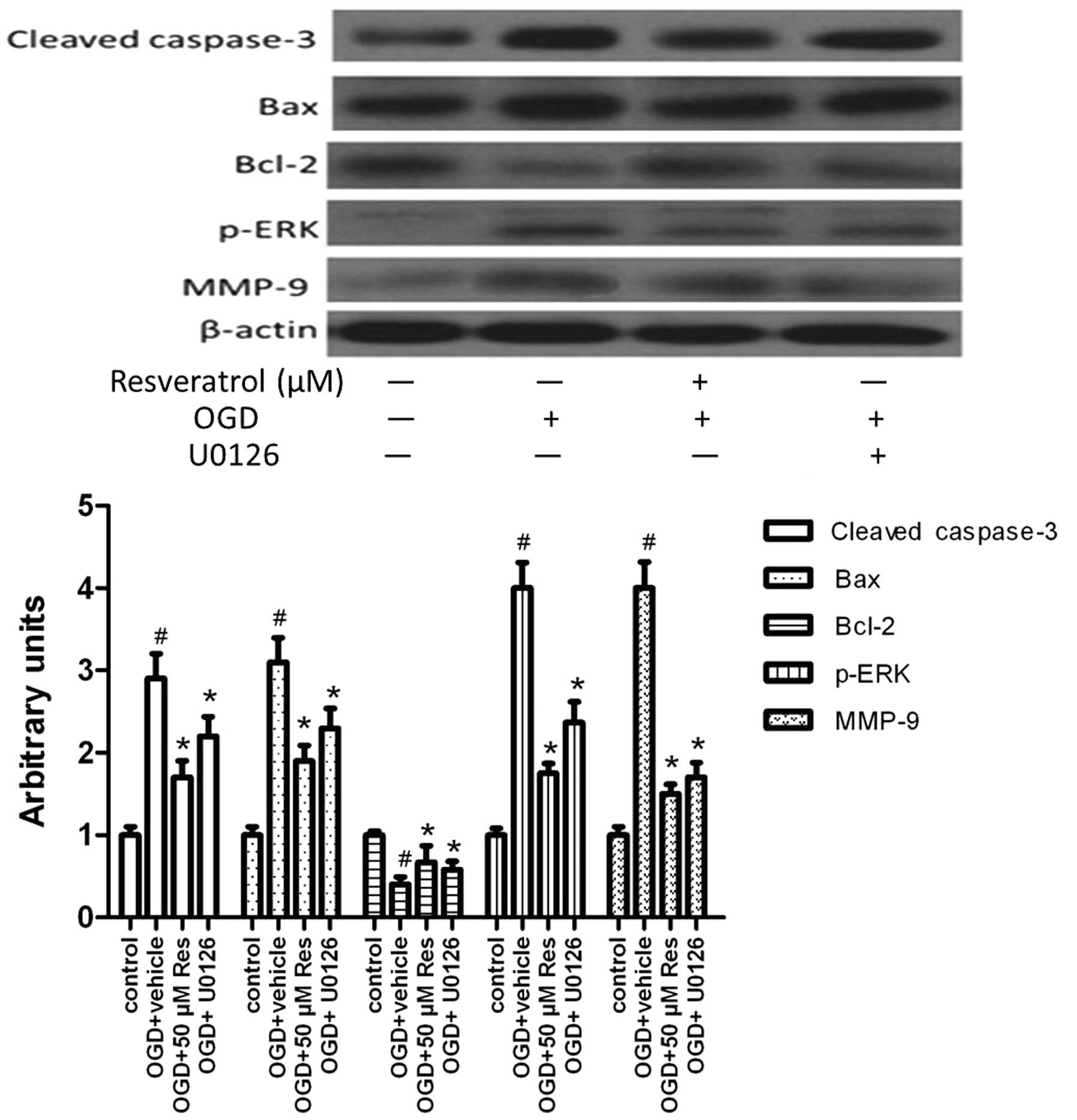Resveratrol protects primary cortical neuron cultures from transient oxygen‑glucose deprivation by inhibiting MMP‑9
- Authors:
- Published online on: March 28, 2014 https://doi.org/10.3892/mmr.2014.2086
- Pages: 2197-2204
Abstract
Introduction
The brain is the most vulnerable organ to ischemic infringement. Neuronal apoptosis is involved in the pathophysiology of brain ischemia and reperfusion injury. Therefore, protection from abnormally increased neuronal apoptosis is expected to be beneficial to therapy.
Resveratrol (trans-3,4′,5-trihydroxystilbene) is a natural phytoalexin found in grapes and other plants that has anticancer, neuroprotective and anti-inflammatory effects (1–3). In addition, resveratrol was found to have anti-oxidant and chemopreventive properties (4). Resveratrol was also shown to reduce the size of cerebral infarction in mice (5,6) and demonstrated protective effects against brain injury induced by ischemia-reperfusion in gerbils (6). Its beneficial neuroprotective effect may be due to its inhibitory effect on platelet aggregation, its vasodilating effect, its anti-oxidant activity or the combination of these (5–9).
Inappropriate expression of matrix metalloproteinases (MMPs) is thought to contribute to the pathogenesis of various conditions, such as arthritis, periodontal disease, atherosclerosis, cancer and ischemia (10,11). Among the known MMPs, gelatinase-B (MMP-9) is a key enzyme for the degradation of type IV collagen, which is a major component of the basement membrane (12–14). MMP-9 is expressed at a low level in the brain of healthy adult rats (15). MMP-9 is a key regulator of apoptosis of hypertrophic chondrocytes, and null mutations in the gene can delay apoptosis (16). A previous study from our group demonstrated that cerebral ischemia-reperfusion induces MMP-9 expression in mice (17). However, whether resveratrol is the MMP inhibitor that is associated with cerebral ischemia remains unknown.
In the present study, the effects of resveratrol on injury induced by oxygen-glucose deprivation (OGD), including neuronal apoptosis and changes in the expression of MMP-9, were examined in primary cortical neuron cultures. Potentially relevant protective mechanisms were also investigated.
Materials and methods
Mouse cortical cultures
The present study was approved by the ethics committee of Xijing Hospital (Xi’an, Shaanxi, China). Cultures of cortical neurons from mice were prepared as previously described (18). Timed-pregnant (13–15 days) BALB/c mice were anesthetized with halothane and sacrificed by cervical dislocation. Following dissection of the cortical region of the fetal brain using a somatotype microscope (Beijing Taike Instrument Co., Ltd., Beijing, China), cortical neurons were dispersed by trituration and digestion in 0.25% trypsin (Sigma-Aldrich, St. Louis, MO, USA) for 30 min at 37°C. Then, the cell suspension was centrifuged at 250 × g for 5 min at 4°C and resuspended in dissociating medium [Dulbecco’s modified Eagle’s medium with 10% fetal bovine serum (Gibco, Carlsbad, CA, USA), 10 mM HEPES, 44 mM glucose and 2 mM L-glutamine (all from Sigma-Aldrich)]. Cells (1×106 cells/ml) were plated on poly-L-lysine-coated culture plates. After 24 h, the medium was replaced with Neurobasal medium consisting of 2% B27 supplement, 0.5 mM L-glutamine and 25 μM glutamate (all from Sigma-Aldrich) to minimize glial growth. At 7 days of growth, one-half of the medium was replaced with fresh Neurobasal medium. Experiments were performed on cells from 14- to 16-day cultures.
Simulation of ischemia and reperfusion in vitro
To induce OGD, the medium was removed from the cultures and stored. Cultures were rinsed twice with phosphate-buffered saline (PBS) and low-glucose Dulbecco’s modified Eagle’s medium (Gibco) with 2% B27 was added. Cultures were then transferred to a humidified chamber kept in a 37°C incubator, and subjected to an anaerobic environment of 95% N2 - 5% CO2 for 3 h. Oxygen concentration was maintained at 0.5–1.0%, as monitored by an oxygen analyzer (MSA Medical, Pittsburgh, PA, USA), throughout the experiment. OGD was terminated by adding the stored medium to the cultures, followed by incubation at 37°C in a 5% CO2 atmosphere for 21 h to allow reoxygenation.
Resveratrol and U0126 treatment
A stock solution (100 mM) of resveratrol (Sigma-Aldrich) was prepared in dimethylsulfoxide (DMSO; Sigma-Aldrich) and stored at -20°C. For treatment, resveratrol was diluted in PBS and added to the cultures in order to obtain the desired final concentrations (10, 25, 50 and 100 μM). U0126 (Sigma-Aldrich) is a specific extracellular signal-regulated kinase (ERK) inhibitor. U0126 (5 μg/μl, 4 μl, in DMSO) was added to the cultures 15 min prior to resveratrol treatment at a final concentration of 50 μM. Untreated cultures (vehicle controls for treatment with resveratrol or U0126) received the same amount of the carrier solvent (0.1% DMSO). The duration of the treatment was from OGD until the end of the experiment.
Cell viability assay
The assay is based on measuring the reduction, by dehydrogenases of metabolically active cells, of the MTT tetrazolium (3-(4,5-dimethylthiazolyl-2-)-2,5-diphenyltetrazolium bromide; Sigma-Aldrich) that is yellow, to a purple formazan. The intracellular formazan can be solubilized and quantified by spectrophotometry. Cells from neuronal primary cultures were grown on 96-well plates at a density of 2×105 cells/cm2. At 14 days of growth, cells were subjected to OGD and reoxygenation, with different concentrations of resveratrol added into the medium. After 21 h of reoxygenation, MTT was added to the cells at a final concentration of 0.5 mg/ml and the plates were incubated for 4 h at 37°C. The insoluble formazan product was then precipitated by centrifugation, the supernatant removed, and the crystals were dissolved in 100 μl DMSO. Absorbance at 570 nm was measured using a Bio-Rad microplate reader (Bio-Rad, Hercules, CA, USA). The ratio of the absorbance of treated cells to that of the control cells was calculated and used to represent the percentage of growth inhibition.
Apoptosis assay
Neuronal apoptosis was assayed by flow cytometry using the Annexin V-FITC Apoptosis Detection kit (Sigma-Aldrich) as described previously (19). Briefly, 1×106 single cells per sample were collected after 3 h of OGD and the subsequent 21-h reoxygenation treatment and were washed twice with PBS buffer. Following addition of Annexin V-FITC and incubation for 10 min at room temperature in the dark, the cells were washed and resuspended, and propidium iodide was added to a final concentration of 1 mg/l. Stained cells were analyzed using a FACSCalibur cytometer (BD Biosciences, Mountain View, CA, USA).
Western blot analysis
Following treatment, cells were incubated in lysis buffer (50 mM Tris-HCl, pH 7.6; 150 mM NaCl; 0.1% polyoxyethyleneglycol dodecyl ether; 0.1% deoxycholic acid; 10 μg/ml leupetin; 2 μg/ml aprotinin; and 1 mM phenyl methane sulfonyl fluoride) on ice. Following centrifugation, the supernatant was collected and total protein concentrations were determined using the Bradford assay (Bio-Rad). Equal amounts (30 μg in 10 μl) of total protein extract were mixed with 2× sample buffer (125 mM Tris pH 6.8, 25% (v/v) glycerol, 4% SDS, 10% β-mercaptoethanol), and separated by SDS-PAGE. Next, proteins were transferred onto a nitrocellulose membrane using a commercial semi-dry blotting apparatus (Bio-Rad, Richmond, CA, USA). The membrane was blocked overnight at 4°C by adding 10% non-fat dry milk in Tris-buffered saline (pH 7.4) supplemented with 0.1% Tween-20 (TBS-T). Then, the membrane was incubated with the primary antibodies anti-MMP-9, -β-actin, -Bcl-2 and -Bax (Sigma-Aldrich), polyclonal anti-ERK and -phospho (p)-ERK, and monoclonal anti-caspase-3 (Cell Signaling Technology, Inc., Danvers, MA, USA), all of which were diluted in blocking buffer (Tiangen Biotech Co., Ltd., Beijing, China), for 2 h at room temperature. The primary antibodies targeting MMP-9 and β-actin were diluted with PBS at 1:1,000 and 1:2,000, respectively. After washing with TBS-T, the membrane was incubated at room temperature for 1 h with horseradish peroxidase-conjugated secondary antibodies, i.e., anti-rabbit and anti-rat IgG produced in goat and targeting MMP-9 and β-actin, respectively (Sigma-Aldrich). Detection of the targeted antigens was performed with a standard electrochemical luminescence method (ECL kit; Santa Cruz Biotechnology, Inc., Santa Cruz, CA, USA).
Reverse transcription-polymerase chain reaction (RT-PCR) analysis
Expression of the MMP-9 gene was examined using RT-PCR. Total RNA was isolated using the TRIzol reagent (Invitrogen Life Technologies, Carlsbad, CA, USA), according to the manufacturer’s instructions. Five μg of total RNA were incubated with 100 units of Superscript™ II reverse transcriptase (Invitrogen Life Technologies), dNTPs (175 μM), 200 ng oligo(dT), dithiothreitol (1 μM) and reaction buffer in a final volume of 20 μl, at 37°C for 60 min. In control reaction mixtures, reverse transcriptase A was omitted in order to determine the amplification of contaminating genomic DNA or cDNA. After denaturation at 94°C for 5 min, 1 μl of cDNA was subjected to PCR. PCR amplifications were performed by incubating in the following three conditions: 1, 94°C for 30 sec; 2, 56°C for 1 min; 3, 72°C for 1 min. A total of 35 cycles were performed for the amplification of MMP-9 and 30 cycles for β-actin. The last cycle was followed by 10 min of elongation at 72°C. Primer pairs for the specific amplification of MMP-9 (based on GenBank accession no. Z27231) and β-actin (accession no. V01217) from murine cDNA were the following: MMP-9 forward (bp: 835–854), 5′-TAGTGAGAGACT CTACACAG-3′ and reverse (bp: 1155–1174), 5′-CCACTTCTT GTCAGTGTCGA-3′; β-actin forward (bp: 331–354), 5′-AACCCTAAGGCCAACCGTGAAAAG-3′ and reverse (bp: 551–571), 5′-TCATGAGGTAGTCTGTCAGGT-3′. The lengths of the MMP-9 and β-actin amplicons were 340 and 242 bp, respectively. PCR products were visualized on 1.5% agarose gels stained with ethidium bromide, under a UV transilluminator. Semi-quantitative analysis was conducted using a computerized densitometric imager (Bio-Rad).
Statistical analysis
Results are expressed as mean ± SD from at least three independent experiments. Statistical analysis was performed using Student’s t-tests and one-way analysis of variance. A difference was considered statistically significant at P<0.05 or P<0.01.
Results
Cell viability assay
The MTT cell viability assay is commonly used to analyze metabolic activity in cells. It measures the reduction of tetrazolium salts facilitated by mitochondrial dehydrogenases. A number of factors such as cell number, cell metabolism and mitochondrial activation influence the outcome of this assay. The number of surviving cells is directly proportional to the level of the formed formazan product. Exposure of the cells to OGD for 3 h followed by 21 h of reoxygenation caused a reduction in cell death rate of ~40–50%. Under these conditions, the neuroprotective effect of resveratrol was dose-dependent: 10, 25, 50 and 100 μM of resveratrol reduced OGD-induced cell death by 30, 50, 75 and 78%, respectively. Treatment with a minimal dose of 50 μM resveratrol had a significantly beneficial effect on cell viability, with no deleterious side-effects observed at/below 100 μM (Fig. 1).
OGD-induced cell apoptosis is attenuated in resveratrol-treated cells
To quantify neuronal apoptosis induced by OGD, flow cytometry was used. As shown in Fig. 2, under normal conditions, the level of neuronal apoptosis is very low (10.9%). Following OGD insult, the percentage of apoptosis was markedly increased, reaching 51% (P<0.01). Treatment with 25, 50 and 100 μM of resveratrol prior to OGD significantly decreased the percentage of apoptotic cells to 35.9, 29.6 and 25% (P<0.05), respectively; treatment with a lower dose (10 μM) of resveratrol also decreased the percentage of apoptotic cells at 43.5%, but this change was not significant (P>0.05). The vehicle solution (DMSO) had no effect on cell apoptosis induced by OGD (P>0.05).
Resveratrol influences the apoptotic signaling pathway
To gain further insight into the mechanism by which resveratrol attenuated OGD-induced cell apoptosis, we studied the changes in gene expression of genes associated with apoptosis. Subjection of cells to OGD induced cleavage of caspase-3 (Fig. 3), and 50 or 100 μM of resveratrol significantly decreased the level of cleaved caspase-3 (P<0.05). The expression of the Bax protein was also induced by OGD and decreased by resveratrol (Fig. 3). We further examined the expression of the Bcl-2 protein. OGD decreased Bcl-2 expression, an effect reversed by resveratrol (Fig. 3). These results suggested that resveratrol exerts anti-apoptotic effects via regulating proteins of the canonical apoptotic signaling pathway.
Effect of resveratrol on MMP-9 expression
To gain further insight into the neuroprotective properties of resveratrol, we studied its effect on the expression of MMP-9. In western blot analysis, the 105-kDa latent form of MMP-9 was detected in all samples. Exposure of the cells to OGD for 3 h followed by 21 h of reoxygenation induced a significant increase in expression of MMP-9 compared to the control; this elevation in the protein level of MMP-9 was reverted by resveratrol treatment in a dose-dependent manner. Under simulated ischemic conditions, cells treated with 25 μM resveratrol had a lower level of MMP-9 compared to cells treated with the carrier solvent solution (vehicle), while even lower levels of MMP-9 were detected in cells treated with 50 and 100 μM resveratrol. However, the amount of detected protein was not significantly different between the two latter treatments. The level of the 42 kDa protein β-actin was used as an internal control and did not significantly change among samples (Fig. 4).
To determine whether resveratrol is involved in the regulation of MMP-9 at the mRNA level, we carried out semi-quantitative RT-PCR experiments. In cells exposed to OGD for 3 h followed by 21 h of reoxygenation, MMP-9 was prominently expressed, while almost no mRNAs were detected in the control. However, in the resveratrol-treated cells, the level of MMP-9 mRNA was reduced compared to the OGD group, with the reduction being statistically significant at higher doses. By contrast, the β-actin mRNA level remained unchanged (Fig. 5). Taken together, these results indicated that resveratrol may be involved in the regulation of the expression of the MMP-9 gene. The observed changes in the level of the MMP-9 mRNA evaluated by RT-PCR demonstrated that resveratrol suppresses transient OGD-induced expression of MMP-9 by inhibiting the gene’s transcription.
Resveratrol influences the activation of ERK
ERK plays a crucial role in almost all cell functions; ERK activity mediates distinct antiproliferative events, for example in apoptosis (20). Since the phosphorylated form of the protein is the active form, we determined the phosphorylated/total ERK protein ratio. As shown in Fig. 6, OGD significantly increased the level of activated ERK (P<0.05), and this effect was reversed by resveratrol at concentrations of 50 and 100 μM (P<0.05). This result suggests that ERK plays an important role in OGD-induced cell apoptosis.
Resveratrol inhibits OGD-induced MMP-9 expression and cell apoptosis via ERK1/2
To investigate the pathway via which resveratrol exerts neuroprotective effects, we studied the effect of resveratrol on the protein level of activated ERK, that of MMP-9 and of proteins related to cell apoptosis. Cells were pretreated with U0126 15 min prior to resveratrol treatment. Resveratrol was added to the cultures at a final concentration of 50 μM. Untreated cultures received an equivalent volume of carrier solvent (0.1% DMSO). The duration of the treatment was from OGD until the end of the experiment. U0126 treatment inhibited MMP-9 expression and activation (cleavage) of caspase-3, as well as Bax expression, but promoted the expression of the anti-apoptotic molecule Bcl-2 (Fig. 7). The level of activated ERK (p-ERK) was reduced by U0126 treatment. This suggests that resveratrol inhibits MMP-9 expression and cell apoptosis via attenuating the activation of ERK1/2.
Discussion
Stroke annually causes brain injury in millions of individuals worldwide. However, there is currently no approved therapy that can reduce infarction size or neurological disability (21,22). An altered blood supply in the brain (ischemia) deprives brain cells of glucose and oxygen, causing irreversible brain damage within minutes. The brain is particularly vulnerable to ischemia due to: i) the very high rate of oxidative metabolism in this organ, requiring a continuous supply of oxygen and glucose; ii) the metabolic interdependence of neurons and astrocytes, two types of brain cells; and iii) the sensitivity of neurons to disruptions in ion homeostasis caused by ischemia (23). Although ischemia is a well-recognized cause of cellular damage, the underlying mechanism is not fully understood.
It has been reported that an antioxidant which has a neuroprotective effect in ischemic brain injury is involved in neuronal apoptosis (24). Apoptosis occurs in vulnerable neurons, such as the cortex and the hippocampus, during early reperfusion (25). Resveratrol shows biological and pharmacological effects on cells, including anti-oxidant, -inflammatory, -mutagenic, -carcinogenic and -apoptotic (26).
Previous reports highlighted MMP-9 as a key factor in brain injury following cerebral ischemia reperfusion, and suggested that this protein may represent a new therapeutic target (27,28). We previously verified that resveratrol has neuroprotective effects and can reduce the elevated level of MMP-9 induced by cerebral ischemia-reperfusion in a murine model of transient middle cerebral artery occlusion (17). Both the total protein and RNA levels of MMP-9 were examined in cerebral tissue. MMP-9 is a key regulator of apoptosis of hypertrophic chondrocytes, and null mutations in the gene can delay apoptosis (16). MMP-9 controls Schwann cell proliferation and phenotypic remodeling via IGF-1 and ErbB receptor-mediated activation of the MEK/ERK pathway (29).
We examined the viability of cells subjected to transient OGD for different periods in pilot MTT experiments, and found that a 3-h OGD followed by 21 h of reoxygenation caused death in ~50% of the cells and was the most suitable condition for establishing stable ischemia in vitro. Resveratrol is a polyphenolic compound. It can be fully dissolved in DMSO at high densities and stored at −80°C for a long period. The highest dose of resveratrol used in our study was 100 μM, containing 0.1% DMSO. Pilot experiments showed that 0.01–0.2% DMSO has no harmful effects on cells when added to the culture medium alone, which allowed to exclude potential confounding effects of this solvent on the results obtained from resveratrol treatment. Therefore, the cell viability assay demonstrated that resveratrol treatment has protective effects against transient OGD in primary cortical neuron cultures.
In the present study, we investigated the protective effects of resveratrol at the cellular level by studying its anti-apoptotic effect and the effect on expression of MMP-9 in both vehicle- and resveratrol-treated primary cortical neuron cultures. We found that OGD insult caused a marked increase in the percentage of apoptotic cells (51%), which was reduced by the addition of resveratrol in a dose-dependent manner. Results of western blot analysis showed that resveratrol decreased the high level of the MMP-9 protein (105 kDa), which was induced by transient OGD. The most significant results were observed at the 50–100 μM doses.
Caspases play an important role in the apoptotic process. Caspase-3 activates the DNA fragmentation factor, which in turn activates endonucleases to cleave nuclear DNA and ultimately leads to cell death (30). In the present study, OGD led to an increase in caspase-3 activity, but resveratrol treatment effectively inhibited the activation of caspase-3.
Bcl-2 is a member of the anti-apoptotic Bcl-2 family, which plays a key role in regulating mitochondrial-mediated apoptotic cell death and can attenuate caspase-3 activation (31,32). In the present study, OGD induced a decrease in the Bcl-2 protein level in cortical cells, whereas Bcl-2 expression was increased in cells treated with resveratrol. The Bax protein belongs to the Bcl-2 gene family and can repress the function of Bcl-2 by forming a dimer with Bcl-2. OGD induced the expression of Bax, the level of which was effectively suppressed following treatment with resveratrol.
ERK activation controls various cell responses, such as proliferation, migration, differentiation, and death (33). Resveratrol potently and efficiently inhibits ERK signaling in sensory neurons in vitro (34). We found that resveratrol can inhibit the activation of ERK in a dose-dependent manner. In addition, we explored the relationship between resveratrol, ERK, MMP-9 and cell apoptosis. U0126, a specific inhibitor of ERK, was added to cortical cultures and was found to have a similar effect on ERK activation, MMP-9 and cell apoptosis to that exerted by resveratrol.
Overall, our results indicate that OGD induces apoptosis through regulating canonical apoptosis signaling and the expression of MMP-9; the anti-apoptotic effect of resveratrol, along with the inhibition of MMP-9 expression it causes contribute to the suppression of ERK activation. The results reported here further support that resveratrol, contained in red wine and other natural products, has neuroprotective effects in cerebral ischemia. Thus, resveratrol may be considered a suitable candidate drug for stroke treatment.
Acknowledgements
This study was supported by a research grant from the National Natural Science Fund of China (no. 30901553).
References
|
Celotti E, Ferrarini R, Zironi R, et al: Resveratrol content of some wines obtained from dried Valpolicella grapes: Recioto and Amarone. J Chromatogr A. 730:47–52. 1996. View Article : Google Scholar : PubMed/NCBI | |
|
Pany S, Majhi A and Das J: PKC activation by resveratrol derivatives with unsaturated aliphatic chain. PLoS One. 7:e528882012. View Article : Google Scholar : PubMed/NCBI | |
|
Das J, Pany S and Majhi A: Chemical modifications of resveratrol for improved protein kinase C alpha activity. Bioorg Med Chem. 19:5321–5333. 2011. View Article : Google Scholar : PubMed/NCBI | |
|
Kesherwani V, Atif F, Yousuf S, et al: Resveratrol protects spinal cord dorsal column from hypoxic injury by activating Nrf-2. Neuroscience. 241:80–88. 2013. View Article : Google Scholar : PubMed/NCBI | |
|
Huang SS, Tsai MC, Chih CL, et al: Resveratrol reduction of infarct size in Long-Evans rats subjected to focal cerebral ischemia. Life Sci. 69:1057–1065. 2001. View Article : Google Scholar : PubMed/NCBI | |
|
Wang Q, Xu J, Rottinghaus GE, et al: Resveratrol protects against global cerebral ischemic injury in gerbils. Brain Res. 958:439–447. 2002. View Article : Google Scholar : PubMed/NCBI | |
|
Doyle GA, Pierce RA and Parks WC: Transcriptional induction of collagenase-1 in differentiated monocyte-like (U937) cells is regulated by AP-1 and an upstream C/EBP-beta site. J Biol Chem. 272:11840–11849. 1997. View Article : Google Scholar : PubMed/NCBI | |
|
Lu X, Xu H, Sun B, et al: Enhanced neuroprotective effects of resveratrol delivered by nanoparticles on hydrogen peroxide-induced oxidative stress in rat cortical cell culture. Mol Pharm. 10:2045–2053. 2013. View Article : Google Scholar : PubMed/NCBI | |
|
de la Torre E, Hovsepian E, Penas FN, et al: Macrophages derived from septic mice modulate nitric oxide synthase and angiogenic mediators in the heart. J Cell Physiol. 228:1584–1593. 2013.PubMed/NCBI | |
|
Pfefferkorn T and Rosenberg GA: Closure of the blood-brain barrier by matrix metalloproteinase inhibition reduces rtPA-mediated mortality in cerebral ischemia with delayed reperfusion. Stroke. 34:2025–2030. 2003. View Article : Google Scholar | |
|
Dufour A and Overall CM: Missing the target: matrix metalloproteinase antitargets in inflammation and cancer. Trends Pharmacol Sci. 34:233–242. 2013. View Article : Google Scholar : PubMed/NCBI | |
|
Saarialho-Kere UK, Welgus HG and Parks WC: Distinct mechanisms regulate interstitial collagenase and 92-kDa gelatinase expression in human monocytic-like cells exposed to bacterial endotoxin. J Biol Chem. 268:17354–17361. 1993. | |
|
Nagaoka I and Hirota S: Increased expression of matrix metalloproteinase-9 in neutrophils in glycogen-induced peritoneal inflammation of guinea pigs. Inflamm Res. 49:55–62. 2000. View Article : Google Scholar : PubMed/NCBI | |
|
Nguyen M, Arkell J and Jackson CJ: Human endothelial gelatinases and angiogenesis. Int J Biochem Cell Biol. 33:960–970. 2001. View Article : Google Scholar : PubMed/NCBI | |
|
Cayabyab FS, Gowribai K and Walz W: Involvement of matrix metalloproteinases-2 and -9 in the formation of a lacuna-like cerebral cavity. J Neurosci Res. 91:920–933. 2013. View Article : Google Scholar : PubMed/NCBI | |
|
Vu TH, Shipley JM, Bergers G, et al: MMP-9/gelatinase B is a key regulator of growth plate angiogenesis and apoptosis of hypertrophic chondrocytes. Cell. 93:411–422. 1998. View Article : Google Scholar : PubMed/NCBI | |
|
Gao D, Zhang X, Jiang X, et al: Resveratrol reduces the elevated level of MMP-9 induced by cerebral ischemia-reperfusion in mice. Life Sci. 78:2564–2570. 2006. View Article : Google Scholar : PubMed/NCBI | |
|
Tauskela JS, Comas T, Hewitt K, et al: Cross-tolerance to otherwise lethal N-methyl-D-aspartate and oxygen-glucose deprivation in preconditioned cortical cultures. Neuroscience. 107:571–584. 2001. View Article : Google Scholar : PubMed/NCBI | |
|
Gong QH, Wang Q, Shi JS, et al: Inhibition of caspases and intracellular free Ca2+ concentrations are involved in resveratrol protection against apoptosis in rat primary neuron cultures. Acta Pharmacol Sin. 28:1724–1730. 2007.PubMed/NCBI | |
|
Cagnol S and Chambard JC: ERK and cell death: mechanisms of ERK-induced cell death - apoptosis, autophagy and senescence. FEBS J. 277:2–21. 2010. View Article : Google Scholar : PubMed/NCBI | |
|
Schaller B and Graf R: Cerebral ischemia and reperfusion: the pathophysiologic concept as a basis for clinical therapy. J Cereb Blood Flow Metab. 24:351–371. 2004. View Article : Google Scholar : PubMed/NCBI | |
|
Moskowitz MA, Lo EH and Iadecola C: The science of stroke: mechanisms in search of treatments. Neuron. 67:181–198. 2010. View Article : Google Scholar : PubMed/NCBI | |
|
Hayashi T and Abe K: Ischemic neuronal cell death and organellae damage. Neurol Res. 26:827–834. 2004. View Article : Google Scholar : PubMed/NCBI | |
|
Fujimura M, Tominaga T and Chan PH: Neuroprotective effect of an antioxidant in ischemic brain injury: involvement of neuronal apoptosis. Neurocrit Care. 2:59–66. 2005. View Article : Google Scholar : PubMed/NCBI | |
|
Krause GS, White BC, Aust SD, et al: Brain cell death following ischemia and reperfusion: a proposed biochemical sequence. Crit Care Med. 16:714–726. 1988. View Article : Google Scholar : PubMed/NCBI | |
|
Lee MK, Kang SJ, Poncz M, et al: Resveratrol protects SH-SY5Y neuroblastoma cells from apoptosis induced by dopamine. Exp Mol Med. 39:376–384. 2007. View Article : Google Scholar : PubMed/NCBI | |
|
Magnoni S, Baker A, George SJ, et al: Differential alterations in the expression and activity of matrix metalloproteinases 2 and 9 after transient cerebral ischemia in mice. Neurobiol Dis. 17:188–197. 2004. View Article : Google Scholar : PubMed/NCBI | |
|
Deng X, Zhong Y, Gu L, et al: MiR-21 involve in ERK-mediated upregulation of MMP9 in the rat hippocampus following cerebral ischemia. Brain Res Bull. 94:56–62. 2013. View Article : Google Scholar : PubMed/NCBI | |
|
Chattopadhyay S and Shubayev VI: MMP-9 controls Schwann cell proliferation and phenotypic remodeling via IGF-1 and ErbB receptor-mediated activation of MEK/ERK pathway. Glia. 57:1316–1325. 2009. View Article : Google Scholar : PubMed/NCBI | |
|
Wang XJ and Xu JX: Salvianic acid A protects human neuroblastoma SH-SY5Y cells against MPP+-induced cytotoxicity. Neurosci Res. 51:129–138. 2005. View Article : Google Scholar : PubMed/NCBI | |
|
Sawada M, Nakashima S, Banno Y, et al: Influence of Bax or Bcl-2 overexpression on the ceramide-dependent apoptotic pathway in glioma cells. Oncogene. 19:3508–3520. 2000. View Article : Google Scholar : PubMed/NCBI | |
|
Yamakawa H, Ito Y, Naganawa T, et al: Activation of caspase-9 and -3 during H2O2-induced apoptosis of PC12 cells independent of ceramide formation. Neurol Res. 22:556–564. 2000.PubMed/NCBI | |
|
Murphy LO and Blenis J: MAPK signal specificity: the right place at the right time. Trends Biochem Sci. 31:268–275. 2006. View Article : Google Scholar : PubMed/NCBI | |
|
Tillu DV, Melemedjian OK, Asiedu MN, et al: Resveratrol engages AMPK to attenuate ERK and mTOR signaling in sensory neurons and inhibits incision-induced acute and chronic pain. Mol Pain. 8:52012. View Article : Google Scholar : PubMed/NCBI |



